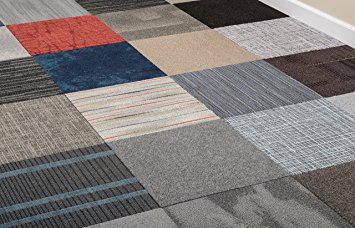Carpet tiles
Carpet tiles, also known as carpet squares, are a type of flooring which can be used as an alternative to the more common rolled carpet. They are formed from an upper layer of pile attached to a backing and are produced in a variety of sizes, materials, fibres, patterns and colours. Carpet tiles are often used in commercial and public buildings such as airports, offices, schools, libraries, and so on.
For the different types of carpet fibers, see Types of carpet.
Carpet tiles are manufactured in both non-adhesive (require gluing) and adhesive (peel-and-stick) styles.
When choosing tiles, it is important to consider the overall design scheme and the requirements of the finished floor, as well as the size and durability of the tiles required.
Some of the benefits of using carpet tiles include:
- They can be easier to install than rolled carpet.
- They can be installed over many floor types, including timber and concrete.
- Individual tiles can be removed and replaced for cleaning or if they get damaged.
- Creative patterned designs can be achieved.
- Many tiles are manufactured with good stain resistant properties.
Some of the drawbacks of using carpet tiles include:
- The seams of the tiles are more visible than rolled carpet and so require careful installation to avoid an uneven appearance.
- They can have a 'corporate' or 'municipal' feel.
- They can become unstuck, and curling or lifting at edges can create a trip hazard.
- They can be more difficult to remove than rolled carpet, which can be easily lifted.
- They can make access to under-floor services more difficult.
- They are generally not suitable for areas where they may be exposed to moisture.
- They can be more expensive than rolled carpet.
[edit] Related articles on Designing Buildings Wiki
Featured articles and news
Amendment to the GB Energy Bill welcomed by ECA
Move prevents nationally-owned energy company from investing in solar panels produced by modern slavery.
Gregor Harvie argues that AI is state-sanctioned theft of IP.
Heat pumps, vehicle chargers and heating appliances must be sold with smart functionality.
Experimental AI housing target help for councils
Experimental AI could help councils meet housing targets by digitising records.
New-style degrees set for reformed ARB accreditation
Following the ARB Tomorrow's Architects competency outcomes for Architects.
BSRIA Occupant Wellbeing survey BOW
Occupant satisfaction and wellbeing tool inc. physical environment, indoor facilities, functionality and accessibility.
Preserving, waterproofing and decorating buildings.
Many resources for visitors aswell as new features for members.
Using technology to empower communities
The Community data platform; capturing the DNA of a place and fostering participation, for better design.
Heat pump and wind turbine sound calculations for PDRs
MCS publish updated sound calculation standards for permitted development installations.
Homes England creates largest housing-led site in the North
Successful, 34 hectare land acquisition with the residential allocation now completed.
Scottish apprenticeship training proposals
General support although better accountability and transparency is sought.
The history of building regulations
A story of belated action in response to crisis.
Moisture, fire safety and emerging trends in living walls
How wet is your wall?
Current policy explained and newly published consultation by the UK and Welsh Governments.
British architecture 1919–39. Book review.
Conservation of listed prefabs in Moseley.
Energy industry calls for urgent reform.

























